Sin Yun-bok
Shin Yun-bok, better known by his pen name Hyewon (1758–1813), was a Korean painter of the Joseon Dynasty. Like his contemporaries Danwon and Geungjae, he is known for his realistic depictions of daily life in his time. His genre paintings are distinctly more erotic than Danwon's, a fact which contributed to his expulsion from the royal painting institute, Dohwaseo.[1] Painting was frequently a hereditary occupation in the Joseon period, and Hyewon's father and grandfather had both been court painters. Together with Danwon and the later painter Owon, Hyewon is remembered today as one of the "Three Wons" of Joseon-period painting.[2]
| Sin Yun-bok | |
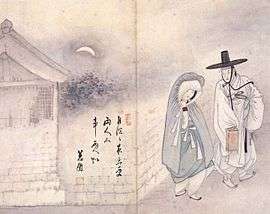 | |
| Korean name | |
|---|---|
| Hangul | 신윤복 |
| Hanja | 申潤福 |
| Revised Romanization | Sin Yun-bok |
| McCune–Reischauer | Sin Yunbok |
| Pen name | |
| Hangul | 혜원 |
| Hanja | 蕙園 |
| Revised Romanization | Hye-won |
| McCune–Reischauer | Hyewŏn |
| Courtesy name | |
| Hangul | 입부 |
| Hanja | 笠父 |
| Revised Romanization | Ip-bu |
| McCune–Reischauer | Ippu |
| Wikimedia Commons has media related to Shin Yun-bok. |
He is Shin Mal Joo's descendant who was a scholar of the early Joseon Dynasty.[3]
Biography
Not much is known about Shin Yun-bok's life. He was the son of royal court painter Hanpyeong (한평; 漢枰), who had participated in painting the royal portraits of Yeongjo and Jeongjo.[4] Hyewon reached the official rank of cheomjeoljesa (첨절제사; 僉節制使) at the Dohwaseo and was adept at different styles of painting; genre, landscape, and animals.[5] It is speculated that he left a great number of paintings due to the popularity of genre paintings during that era.[6]
There are different studies and theories regarding his life, that he may not have ever been a member of the Dohwaseo nor was he on close terms with Kim Hong-do.[7]
Style and legacy
Shin Yun-bok, despite being greatly influenced and overshadowed by Kim Hong-do during his career, developed his own unique technique and artistry.[8] Along with Kim Hong-Do, he is known foremost for his genre paintings of the Joseon era.[9] Whereas Kim depicted everyday life of peasants with a humorous touch, Shin showed glimpses of eroticism in his paintings of townspeople and gisaeng.[10] His choice of characters, composition, and painting method differed from Kim's, with use of bright colors and delicate paint strokes. He also painted scenes of shamanism and townlife, offering insight to lifestyle and costumes of the late Joseon era.[5][8]
His ink landscape paintings used clear light strokes in a method similar to that of Yun Je-hong (윤제홍), the pioneer in new style painting of the late Joseon era. He is also known to not have used the traditional method of leaving empty space in his paintings, usually filling the whole canvas.[11] Although he placed short verse and his seal on most of his paintings, none indicate the date nor time of their creation and it is difficult to define the progression of his painting style. As one of the pillars of genre painting in the Joseon era, he influenced many other painters afterwards.[8][12]
His album, Hyewon Pungsokhwacheop, contains 30 of his paintings and was designated the 135th National Treasure of South Korea in 1970.[11]
Famous paintings
- Portrait of a Beauty (미인도; 美人圖): Painting on silk. Depicts the standard of traditional beauty in the Joseon era.[10] Realistic details of the hanbok are notable.[13]
- Dano day (단오풍정; 端午風情): Painting on paper. Depicts a scene on Dano day; semi-nudes bathing in the stream, a woman in a bright red hanbok rides a swing, two young monks peek in the background.[14]
Gallery
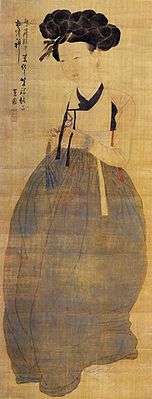 Portrait of a Beauty
Portrait of a Beauty
(미인도 美人圖)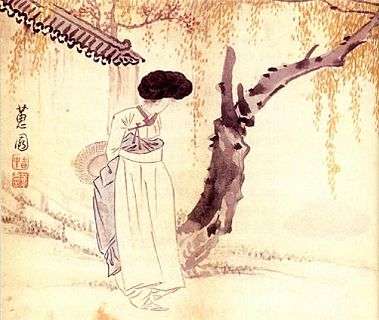 Waiting
Waiting
(기다림)
Six paintings from the Yeosokdo Album (여속도첩):
 Woman with a cap
Woman with a cap
(처네를쓴 여인) Women at fish market
Women at fish market
(어물장수) Women playing
Women playing
geomungo
(거문고 고르는 여인)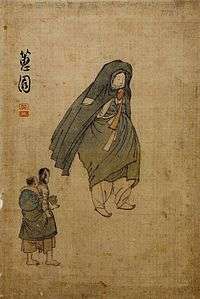 Woman with a jangot
Woman with a jangot
(장옷 입은 여인) Woman with a red hat
Woman with a red hat
(전모쓴 여인) Woman at Yeondang
Woman at Yeondang
(연당의 여인)
Four paintings from the Pungsokdo Album. See Hyewon pungsokdo for a complete gallery of this album (30 paintings).
 Scenery on Dano day
Scenery on Dano day
(단오풍정 端午風情)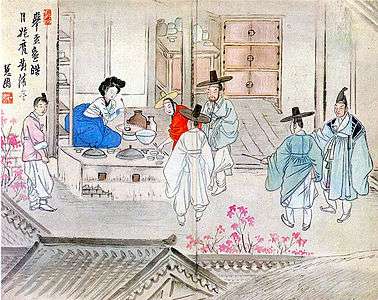 Holding a drinking bout
Holding a drinking bout
(주사거배 酒肆擧盃)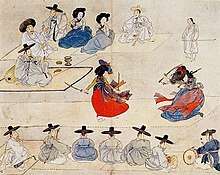 Dance with two swords
Dance with two swords
(쌍검대무 雙劍對舞)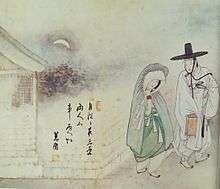 Lovers under the moon
Lovers under the moon
(월하정인 月下情人)
Fictional portrayals
Literature
In the novel Painter of the Wind by Lee Jung-myung, Hyewon is portrayed as a woman disguised as a man.[15]
Film and television
- Portrayed by Moon Geun-young and Kim Yoo-jung in the 2008 SBS TV series Painter of the Wind.
- Portrayed by Kim Min-sun in the 2008 film Portrait of a Beauty.[16]
References
- Choi Yongbeom (최용범), Reading Korean history in one night (하룻밤에 읽는 한국사) p299, Paper Road, Seoul, 2007. ISBN 89-958266-3-0.
- (in Korean) Shin Yun-bok at Daum Culture Dictionary
- 수정: 2016.03.21 21:23, 입력: 2016 03 21 21:12 (2016-03-21). [강명관의 심심한 책읽기]족보가 있는지?. news.khan.co.kr (in Korean). Retrieved 2019-05-13.
- Lee Younghwa (이영화), Joseon era, Joseon people (조선시대, 조선사람들) p102, Garam Publishing, Seoul, 1998. ISBN 89-85466-02-X
- (in Korean) Shin Yun-bok Archived 2011-06-10 at the Wayback Machine at Encyclopedia of Korean Culture
- (in Korean) Shin Yun-bok at Doosan Encyclopedia
- (in Korean) 3 mysteries of Shin Yun-bok, Maekyung, 2008-10-22. Retrieved 2010-07-07.
- (in Korean) Shin Yun-bok at The Academy of Korean Studies
- Pratt 1999, pp. 421–422
- Turner 2003, p. (28)782
- (in Korean) Hyewon pungsokdo at Doosan Encyclopedia
- (in Korean) Shin Yun-bok Archived 2011-06-10 at the Wayback Machine at Britannica Korea
- (in Korean) Portrait of a beauty at Doosan Encyclopedia
- (in Korean) Scene of Dano at Doosan Encyclopedia
- Lee Jeong-myeong (이정명), Painter of the Wind Vol. 1 & 2, Million House, Seoul, 2007. ISBN 978-89-91643-26-0 & ISBN 978-89-91643-27-7.
- Mysterious Artist Resurfaces on Modern Culture Scene, Korea Times, 2008-10-09. Retrieved 2010-07-07.
Bibliography
- Pratt, Keith L.; Rutt, Richard; Hoare, James E. (1999). Korea, A Historical and Cultural Dictionary. Durham East Asia Series. Routledge. p. 568. ISBN 978-0-7007-0463-7.
- Turner, Jane (2003). Grove Dictionary of Art. Oxford University Press, US. p. 32600. ISBN 978-0-1951-7068-9.CS1 maint: ref=harv (link)
External links
- (in Korean) Brief information about Hyewon from Korean culture figures, Ministry of Culture, Sports and Tourism
- New drama on Joseon's legendary painters from official Korea site, 2008-11-13. Retrieved 2010-07-07.
- Shin Yun-bok in the Spotlight from KBS World, 2008-11-12. Retrieved 2011-02-16.
- Arts of Korea, an exhibition catalog from The Metropolitan Museum of Art Libraries (fully available online as PDF), which contains material on Shin Yun-bok